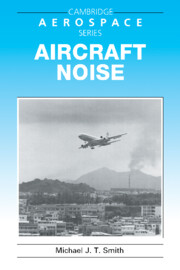Book contents
- Frontmatter
- Contents
- Preface
- Acknowledgments
- 1 Human reaction to aircraft noise
- 2 Action against aircraft noise
- 3 Aircraft noise sources
- 4 Power-plant noise control
- 5 Concorde – a special case
- 6 Noise data acquisition and presentation
- 7 Aircraft noise prediction
- 8 Prospects for the future
- 9 Review
- Appendices
- References
- Index
3 - Aircraft noise sources
Published online by Cambridge University Press: 06 November 2009
- Frontmatter
- Contents
- Preface
- Acknowledgments
- 1 Human reaction to aircraft noise
- 2 Action against aircraft noise
- 3 Aircraft noise sources
- 4 Power-plant noise control
- 5 Concorde – a special case
- 6 Noise data acquisition and presentation
- 7 Aircraft noise prediction
- 8 Prospects for the future
- 9 Review
- Appendices
- References
- Index
Summary
Noise, or unwanted sound, is generated whenever the passage of air over the aircraft structure or through its power-plants causes fluctuating pressure disturbances that propagate to an observer in the aircraft or on the ground below. Since the flight condition cannot be maintained unless these air- and gasflows are controlled efficiently, there are ample opportunities for sound to be produced. Fluctuating pressure disturbances result from inefficiencies in the total system and occur whenever there is a discontinuity in the airflow-handling process, particularly in the engines, where power generation involves large changes in pressure and temperature. This is not to say that the airframe itself is devoid of sound-producing opportunities, for it has a large surface area and, in the configuration that is adopted for take-off and approach, both the landing gear and high-lift devices (slats and flaps) create significant amounts of turbulence.
To the community beneath the aircraft, the self-generated noise from the airframe is normally significant only during the approach phase of operation, where the sources shown in Figure 3.1 can combine to exceed the level of each major noise source in the power-plant. For this reason, airframe noise has been thought of as the ultimate aircraft noise “barrier”. Perhaps we should briefly consider this and other airframe-associated sources before moving into the more complex subject of the aircraft power-plant.
- Type
- Chapter
- Information
- Aircraft Noise , pp. 41 - 119Publisher: Cambridge University PressPrint publication year: 1989
- 2
- Cited by



